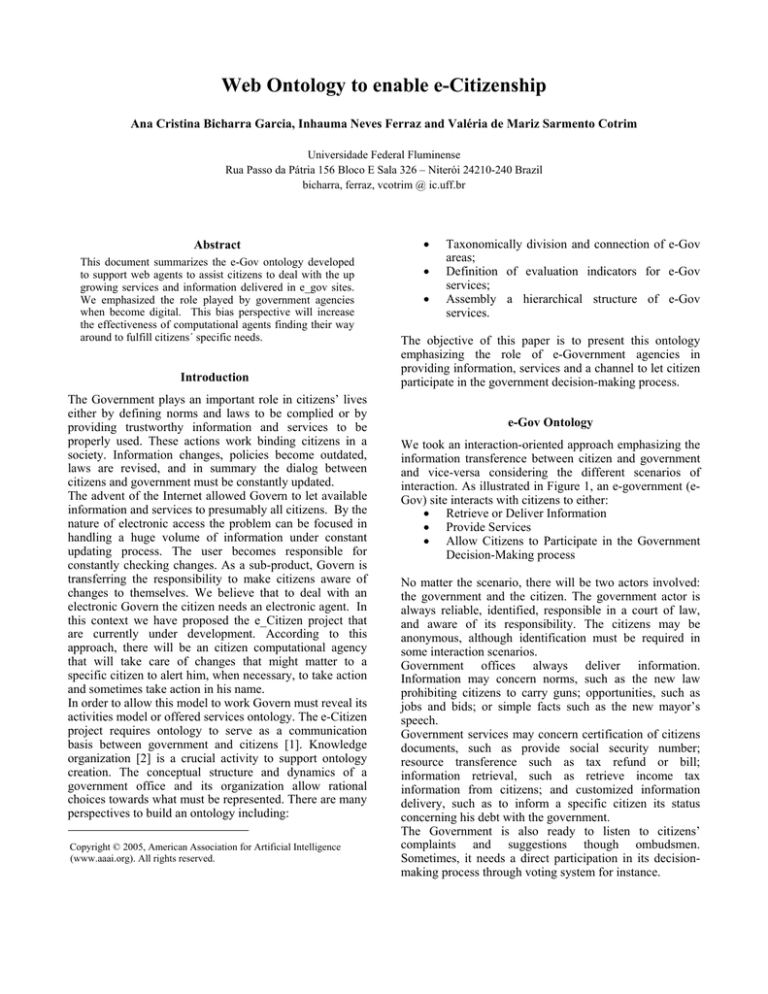
Web Ontology to enable e-Citizenship
Ana Cristina Bicharra Garcia, Inhauma Neves Ferraz and Valéria de Mariz Sarmento Cotrim
Universidade Federal Fluminense
Rua Passo da Pátria 156 Bloco E Sala 326 – Niterói 24210-240 Brazil
bicharra, ferraz, vcotrim @ ic.uff.br
Abstract
This document summarizes the e-Gov ontology developed
to support web agents to assist citizens to deal with the up
growing services and information delivered in e_gov sites.
We emphasized the role played by government agencies
when become digital. This bias perspective will increase
the effectiveness of computational agents finding their way
around to fulfill citizens´ specific needs.
Introduction
The Government plays an important role in citizens’ lives
either by defining norms and laws to be complied or by
providing trustworthy information and services to be
properly used. These actions work binding citizens in a
society. Information changes, policies become outdated,
laws are revised, and in summary the dialog between
citizens and government must be constantly updated.
The advent of the Internet allowed Govern to let available
information and services to presumably all citizens. By the
nature of electronic access the problem can be focused in
handling a huge volume of information under constant
updating process. The user becomes responsible for
constantly checking changes. As a sub-product, Govern is
transferring the responsibility to make citizens aware of
changes to themselves. We believe that to deal with an
electronic Govern the citizen needs an electronic agent. In
this context we have proposed the e_Citizen project that
are currently under development. According to this
approach, there will be an citizen computational agency
that will take care of changes that might matter to a
specific citizen to alert him, when necessary, to take action
and sometimes take action in his name.
In order to allow this model to work Govern must reveal its
activities model or offered services ontology. The e-Citizen
project requires ontology to serve as a communication
basis between government and citizens [1]. Knowledge
organization [2] is a crucial activity to support ontology
creation. The conceptual structure and dynamics of a
government office and its organization allow rational
choices towards what must be represented. There are many
perspectives to build an ontology including:
Copyright © 2005, American Association for Artificial Intelligence
(www.aaai.org). All rights reserved.
•
•
•
Taxonomically division and connection of e-Gov
areas;
Definition of evaluation indicators for e-Gov
services;
Assembly a hierarchical structure of e-Gov
services.
The objective of this paper is to present this ontology
emphasizing the role of e-Government agencies in
providing information, services and a channel to let citizen
participate in the government decision-making process.
e-Gov Ontology
We took an interaction-oriented approach emphasizing the
information transference between citizen and government
and vice-versa considering the different scenarios of
interaction. As illustrated in Figure 1, an e-government (eGov) site interacts with citizens to either:
• Retrieve or Deliver Information
• Provide Services
• Allow Citizens to Participate in the Government
Decision-Making process
No matter the scenario, there will be two actors involved:
the government and the citizen. The government actor is
always reliable, identified, responsible in a court of law,
and aware of its responsibility. The citizens may be
anonymous, although identification must be required in
some interaction scenarios.
Government offices always deliver information.
Information may concern norms, such as the new law
prohibiting citizens to carry guns; opportunities, such as
jobs and bids; or simple facts such as the new mayor’s
speech.
Government services may concern certification of citizens
documents, such as provide social security number;
resource transference such as tax refund or bill;
information retrieval, such as retrieve income tax
information from citizens; and customized information
delivery, such as to inform a specific citizen its status
concerning his debt with the government.
The Government is also ready to listen to citizens’
complaints and suggestions though ombudsmen.
Sometimes, it needs a direct participation in its decisionmaking process through voting system for instance.
•
Project Status
We have developed and initial ontology, as described in
here that will be instantiated to express the Revenue
Service. The purpose of any Revenue Service is to give
taxpayers an efficient service and helping them understand
and meet their tax responsibilities. More than that to apply
the tax law with integrity and fairness. Citizen’s role is to
understand and meet tax obligations. The Secretariat of
Federal Revenue role is to help the compliant taxpayers
and to ensure people who are unwilling to comply pay their
share.
Income taxes are taxes levied on the financial income of
persons or of corporations. Taxes levied on the income of
companies are called corporate taxes, corporate income
taxes or corporation taxes. Secretariat of Federal Revenue
activities encompasses many interspersed activities such
as:
• Citizens information gathering in order to
maintain and update taxpayers file records;
•
•
•
•
•
Enterprises information gathering in order to
maintain and update corporate taxpayers file
records;
Income tax evaluation both for individual income
tax and corporation taxes;
Fraud and tax evasion risk analysis based in
different sources cross-validation;
Notifying taxpayers taxes evaluation results;
Transference of money for the count-chain of the
customer or bank agency in case of tax restitution;
Tax evasion control.
Additionally, we will apply this ontology to describe the
census service office.
This is a 3-years project that is just beginning. We hope to
show the usefulness of an ontology to allow computational
agents to serve citizens to deals with electronic government
services. Additionally, we expect this ontology will be
used by government agencies to develop their sites.
Figure 1: e-Gov Ontology
References
Embley, D. W. 2004. Toward semantic understanding: an
approach based on information extraction ontologies.
Proceedings of the fifteenth conference on Australasian
database - Volume 27 CRPIT '04.
Ingeltraut, A. 1995. Current trends in Knowledge
Organization. In: Organización del Conocimiento en
Sistema de Información y Documentación 1/1995. pgs. 525.





